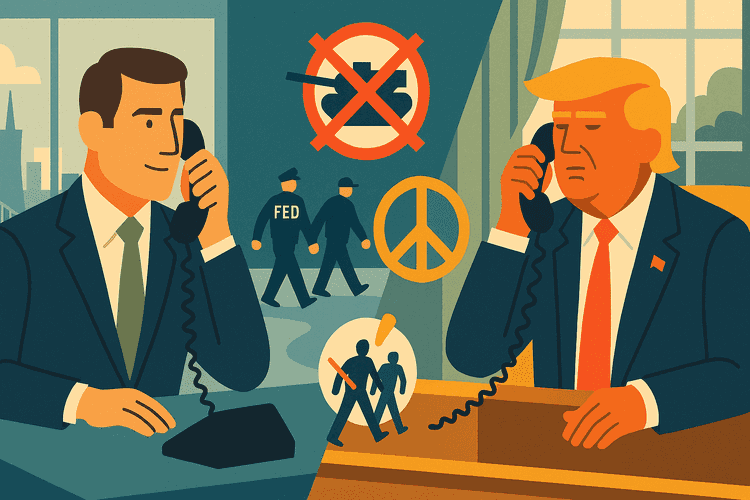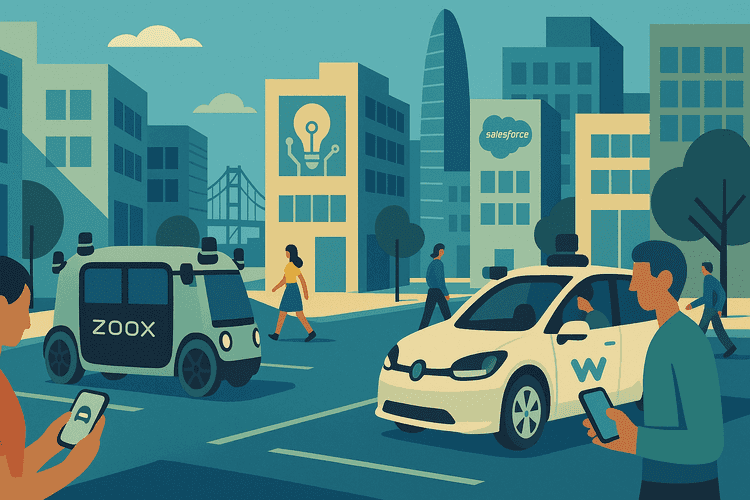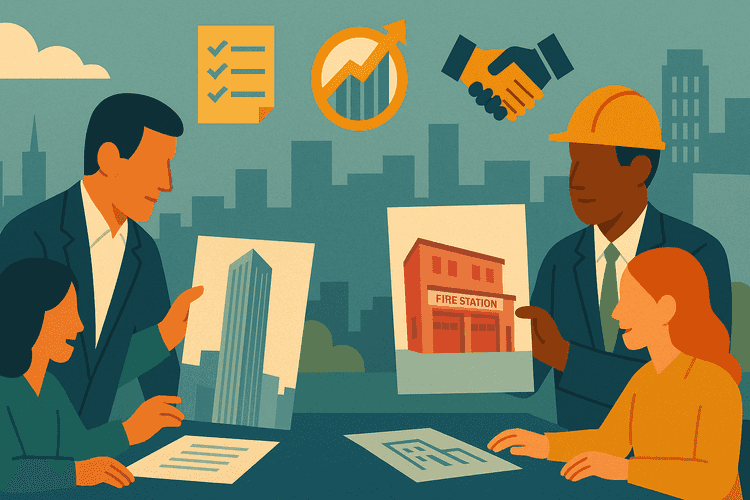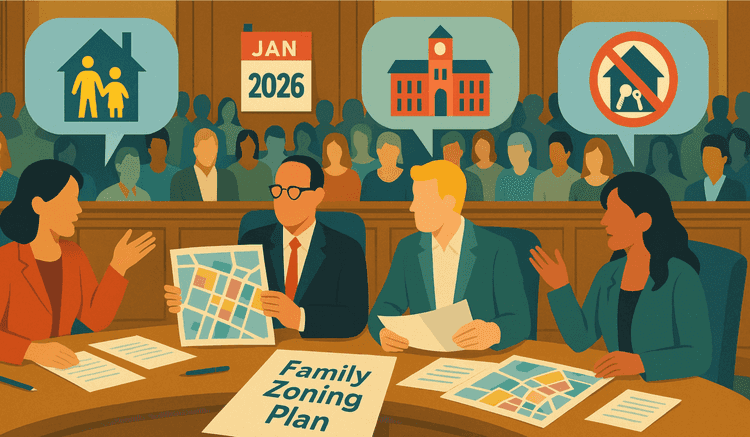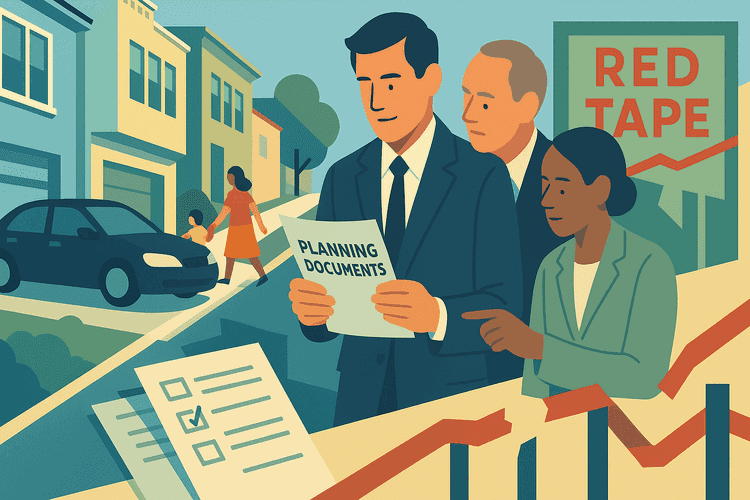Trump Pauses National Guard Deployment to San Francisco
PLUS: Zoox Launches Select Passenger Rides in San Francisco
What You Need To Know
Here’s what happened around the city for the week of October 19, 2025:
- Trump Pauses National Guard Deployment to San Francisco
- Zoox Launches Select Passenger Rides in San Francisco
- Board Approves $750M Downtown Tower With Private Fire Station
- Family Zoning Plan Advances With Amendments
- Planning Commission Approves Common-Sense Driveway Parking Reform
Trump Pauses National Guard Deployment to San Francisco
Published October 24, 2025
The Facts
The National Guard is not being deployed, thanks to Mayor Lurie.
Earlier this week, President Donald Trump announced plans to deploy at least 100 federal immigration officers to San Francisco as part of what he called a federal “surge.” But after a call on Wednesday night with Mayor Daniel Lurie, the President reversed course.
According to Mayor Lurie, he told Trump that San Francisco is on the rise and cited the city’s marked decrease in crime across the board, rise in visitors, declining office vacancies, and the steady return of workers downtown.
By Thursday morning, Trump confirmed on Truth Social that the planned surge was being called off after what he described as “very good conversations” with Mayor Lurie. At a press conference later that day, Lurie confirmed he had also been in contact with Attorney General Pam Bondi to explore ways the city and federal government could work together to curb fentanyl trafficking.
The Context
Over the past few months, the Trump Administration has deployed federal immigration officers and the National Guard to cities across the country, including Chicago, Los Angeles, Portland, Memphis, and Washington, D.C. President Trump has also threatened future military interventions in several other cities, including New York, Baltimore, New Orleans, Oakland, and St. Louis. These deployments have fueled tension and unrest, leading to mass demonstrations, deepening divisions within communities nationwide, as well as chaos and violence.
Violent crime has fallen to lows not seen in decades with homicides on track to hit 70-year lows. Overall crime is down 30 percent citywide, car break-ins are at 22-year lows, and tent encampments have fallen to record lows. Simultaneously, the city’s economic renaissance is in swing, with a 27.3% year-over-year jump in office demand in Q2, and vacancy rates (empty storefronts) decreasing to 6.7% in the second quarter, compared with 7.4% in Q2 of last year. In July, we released a poll that showed that for the first time since 2016, over 50% of San Franciscans say the city is on the right track.
The GrowSF Take
We’re very impressed by Mayor Lurie’s handling of this situation. By engaging directly with President Trump, avoiding inflammatory rhetoric, and inviting help from federal agencies like the DEA and ATF, Lurie brought the temperature down, avoided a National Guard deployment, and shifted the focus to San Francisco’s positive developments.
Zoox Launches Select Passenger Rides in San Francisco
Published October 24, 2025
The Facts
Amazon-owned Zoox has begun offering rides to select passengers in San Francisco, operating in parts of SoMa, the Mission, and the Design District, according to Rya Jetha at The Standard. The service allows friends and family of Zoox employees to ride in the four-passenger, steering-wheel-free vehicles that can drive bidirectionally.
Zoox announced in November 2024 that it would begin testing its robotaxi in San Francisco’s SoMa neighborhood, where it has operated test vehicles with safety drivers since 2017. The company previously launched public rides in Las Vegas in September 2025, offering free rides to passengers on and around the Strip.
The Context
Zoox’s entry is the second meaningful competition to Waymo’s dominance in San Francisco’s autonomous vehicle market, though competitor Cruise stopped serving SF in 2023. The Amazon subsidiary operates purpose-built robotaxis without traditional steering wheels or driver controls, featuring amenities like wireless phone charging and personal climate controls. Arguably, there’s another competitor in Tesla’s taxi service, but its vehicles still require human safety drivers.
The company plans to expand its San Francisco service area gradually, with a full public launch expected in 2026. Zoox operates a production facility in Hayward and has received significant investment from Amazon since its $1.3 billion acquisition in 2020.
Our polling shows huge support for autonomous vehicles - with over two-thirds of San Franciscans expressing support as of mid-2025.
The GrowSF Take
Competition drives innovation, and Zoox’s arrival will push Waymo’s to keep improving. We’re thrilled that San Francisco is embracing futuristic technology instead of shunning it.
Amazon’s substantial backing gives Zoox credible resources to compete long-term, which should accelerate improvements across the entire autonomous vehicle sector. This competition benefits consumers through better service and innovation while attracting the high-tech investment that powers San Francisco’s economic recovery.
Board Approves $750M Downtown Tower With Private Fire Station
Published October 24, 2025
The Facts
The Board of Supervisors unanimously approved Related California’s $750 million development on October 21, passing six ordinances that enable construction of a 41-story office and hotel tower at 530 Sansome Street. The ordinances included zoning amendments to allow the increased height and density, approval of the development agreement, establishment of the public-private fire station partnership, and authorization of the hotel tax incentive financing mechanism.
The project includes an unprecedented arrangement where the private developer will construct and deed to the city a $40 million, four-story fire station to replace Fire Station 13. Under the development agreement, Related will pay $24.1 million in impact fees, including nearly $15 million for affordable housing. The project promises 1,600 permanent jobs with an $816 million economic impact, according to Patrick Hoge at The Examiner.
The City agreed to give over $60 million in tax incentives to the builder over the next 25 years, with economic models projecting the city will receive far more than that in hotel tax revenue on top of the $40M fire station the city receives for free.
The Context
This marks the first new major office tower and luxury hotel approved in San Francisco’s Financial District in recent years, and is a great sign that the commercial real estate market is rebounding.
Related plans to begin construction in late 2026, with completion targeted around 2030. The project received strong support from business groups, hospitality organizations, and labor unions.
The GrowSF Take
We’re glad to see institutional investors and large developers showing confidence in San Francisco’s recovery. The innovative public-private partnership for the fire station is a creative solution to address the city’s infrastructure needs while facilitating new development.
Family Zoning Plan Advances With Amendments
Published October 24, 2025
The Facts
During its first formal consideration of Mayor Lurie’s Family Zoning Plan, the Board’s Land Use Committee heard a slate of amendments that would significantly alter the proposal. The most substantial change came from Supervisor Myrna Melgar, whose rent-control exemption amendment would exempt buildings with three or more rent-controlled units from upzoning—cordoning off roughly 84,000 units in 11,700 buildings from potential redevelopment.
Supervisors Stephen Sherrill and Danny Sauter proposed incentives for two- and three-bedroom units, while Board President Rafael Mandelman sought stronger protections for historic buildings, according to Gabe Greschler at the SF Standard. Progressive Supervisors Chyanne Chen and Connie Chan introduced amendments to exempt some low-income areas and add anti-demolition rules.
The Context
The plan, which would create capacity for roughly 36,000 new homes, is San Francisco’s strategy to meet a state-mandated housing goal. The city faces a January 2026 deadline to pass a compliant rezoning plan or risk a state takeover of local housing approvals and the loss of significant state funding.
The GrowSF Take
The Supervisors are playing with fire. The amendments could severely undermine the plan’s effectiveness: by exempting a large portion of existing housing stock, the city risks falling short of its housing goals and facing state intervention.
The state will not care why San Francisco fails to meet its legal obligations, even if the reasons are well-intentioned. All that matters is whether San Francisco builds, and these additional hurdles will only slow down development and raise the risk of a state takeover.
Some pro-housing advocates invite the meddling, however. If the local plan fails due to NIMBY opposition, a state takeover will allow developers to build whatever they want, wherever they want it, without the constraints of local politics. The opponents to the family zoning plan don’t seem to understand the only two options on the table: either they accept more housing with local oversight, or they risk losing all local control.
Planning Commission Approves Common-Sense Driveway Parking Reform
Published October 24, 2025
The Facts
The San Francisco Planning Commission unanimously approved 7-0 Mayor Daniel Lurie’s proposal Thursday to allow residents to park in their own driveways without requiring decorative screens or fences. The reform eliminates a bizarre regulation that previously made it illegal to park “operable vehicles in the front setback of a property” unless cars were hidden behind barriers.
Under current law, a Noe Valley couple was fined $1,500 in 2022 for parking in their driveway, even though their vehicle didn’t block the sidewalk, according to Renee Koury at ABC 7 news. The city currently has 135 active complaints against residents parking in their own driveways, according to the Planning Department.
The legislation still requires Board of Supervisors approval to take effect.
The Context
This reform is part of Lurie’s PermitSF initiative to eliminate bureaucratic red tape. The proposal allows up to two operable vehicles per driveway and maintains restrictions on boats, trailers, and permanently disabled vehicles. Cars still cannot encroach on sidewalks or public rights-of-way. We first covered this in September when it was first introduced.
The GrowSF Take
Sometimes it’s the little things that really make a difference. For every person hit with a surprise fine for parking in their own driveway, this reform will bring relief.


